|
Our theory for the origin of the Solar System is a very old one with some
modern innovations called the Nebular Hypothesis. A crucial ingredient
in the nebular hypothesis is the conservation of angular momentum.
Conservation of Angular Moment
 Objects executing motion around a point possess a quantity called
angular momentum.
This is an important physical quantity because all experimental
evidence indicates that angular momentum is rigorously conserved in our
Universe: it can be transferred, but it cannot be created or destroyed. For the
simple case of a small mass executing uniform circular motion around a much
larger mass (so that we can neglect the effect of the center of mass) the amount
of angular momentum takes a simple form. As the adjacent figure illustrates the
magnitude of the angular momentum in this case is L = mvr, where
L is the angular momentum, m is the mass of the small object,
v is the magnitude of its velocity, and r is the separation
between the objects.
Objects executing motion around a point possess a quantity called
angular momentum.
This is an important physical quantity because all experimental
evidence indicates that angular momentum is rigorously conserved in our
Universe: it can be transferred, but it cannot be created or destroyed. For the
simple case of a small mass executing uniform circular motion around a much
larger mass (so that we can neglect the effect of the center of mass) the amount
of angular momentum takes a simple form. As the adjacent figure illustrates the
magnitude of the angular momentum in this case is L = mvr, where
L is the angular momentum, m is the mass of the small object,
v is the magnitude of its velocity, and r is the separation
between the objects.
Ice Skaters and Angular Momentum
This formula indicates one important
physical consequence of angular momentum: because the above formula can be
rearranged to give v = L/(mr) and L is a constant for an
isolated system, the velocity v and the separation r are
inversely correlated. Thus, conservation of angular momentum demands
that a decrease in the separation r be accompanied by an increase in
the velocity v, and vice versa. This important concept carries over to
more complicated systems: generally, for rotating bodies, if their radii
decrease they must spin faster in order to conserve angular momentum. This
concept is familiar intuitively to the ice skater who spins faster when the arms
are drawn in, and slower when the arms are extended; although most ice skaters
don't think about it explictly, this method of spin control is nothing but an
invocation of the law of angular momentum conservation.
The Origin
The Nebular Hypothesis in its original form was proposed by Kant and Laplace
in the 18th century. The initial steps are indicated in the following figures.
Collapsing Clouds of Gas and Dust
A great cloud of gas and dust (called a
nebula)
begins to collapse because the gravitational forces that would like to collapse
it overcome the forces associated with gas pressure that would like to expand it
(the initial collapse might be triggered by a variety of perturbations---a
supernova blast wave, density waves in spiral galaxies, etc.).
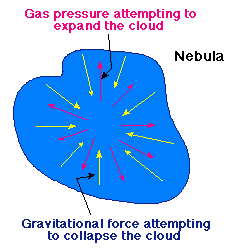 |
 |
| In the Nebular Hypothesis, a cloud of gas and dust
collapsed by gravity begins to spin faster because of angular momentum
conservation |
It is unlikely that such a nebula would be created with no angular momentum,
so it is probably initially spinning slowly. Because of conservation of angular
momentum, the cloud spins faster as it contracts.
The Spinning Nebula Flattens
Because of the competing forces associated
with gravity, gas pressure, and rotation, the contracting nebula begins to
flatten into a spinning pancake shape with a bulge at the center, as illustrated
in the following figure.
 |
| The collapsing, spinning nebula begins to flatten into a rotating pancake
|
Condensation of Protosun and Protoplanets
As the nebula collapses further, instabilities in the collapsing, rotating cloud cause local regions to
begin to contract gravitationally. These local regions of condensation will
become the Sun and the planets, as well as their moons and other debris in the Solar System.
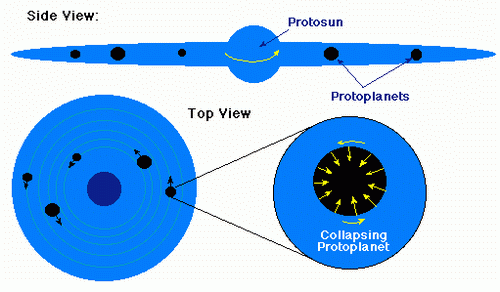 |
| As the nebula collapses further, local regions begin to contract
gravitationally on their own because of instabilities in the collapsing,
rotating cloud |
While they are still condensing, the incipient Sun and planets are called the
protosun and protoplanets, respectively.
Evidence for the Nebular Hypothesis
Because of the original angular
momentum and subsequent evolution of the collapsing nebula, this hypothesis
provides a natural explanation for some basic facts about the Solar System: the
orbits of the planets lie nearly in a plane with the sun at the center (let's
neglect the slight eccentricity of the planetary orbits to simplify the
discussion), the planets all revolve in the same direction, and the planets
mostly rotate in the same direction with rotation axes nearly perpindicular to the orbital plane.
The nebular hypothesis explains many of the basic features of the Solar
System, but we still do not understand fully how all the details are accounted
for by this hypothesis. As we discuss in the next section, we now have some
direct observational evidence in support of the nebular hypothesis.
Solar System in the Making?
The nebular hypothesis for the origin of our Solar System has been bolstered
by a variety of recent observations that look very much like star and planetary
systems in various stages of formation.
New Solar Systems
Recent Hubble
Space Telescope observations shed considerable light on the birth
of stars and associated planetary systems. The following image shows regions
in the Orion
Nebula where solar systems may be forming.
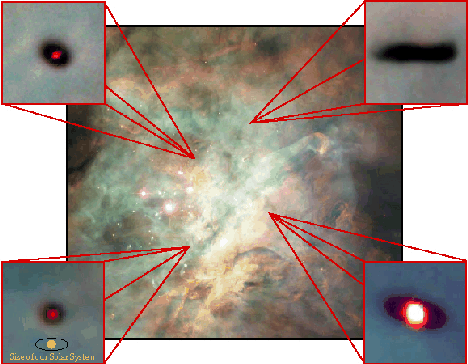 |
| Regions in the Orion Nebula where solar systems appear to
be forming |
The Orion Nebula is approximately 1500 light years from Earth. It is visible
to the naked eye as the middle "star" in the sword of the constellation Orion.
These images were taken with the Wide
Field Planetary Camera 2 of the Hubble Space Telescope (C.R. O'Dell, Rice
University). Details of the images show several protoplanetary disks ( proplyds
), including a single dark disk surrounding a central star (Ref).
The lower left inset figure shows a drawing giving the approximate scale of our
Solar System relative to the proplyd.
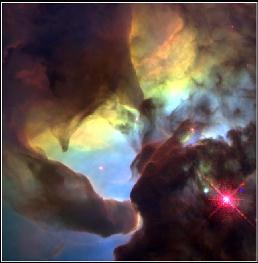
Here is a HST
movie (650 kB MPEG) illustrating these protoplanetary disks in the Orion
Nebula (original movie source), here is
a further
discussion of these planetary systems now forming in Orion.
More Star-Forming Regions
Many other star-forming regions are known. In
addition to the Eagle Nebula discussed below, here are images and discussion of
In each of these examples there is strong evidence that stars are
being born in the region shown in the image; presumably, at least in some of the
cases, attendant solar systems are being formed also.
Star Formation in the Eagle Nebula
The following images show examples in
the Eagle Nebula of regions where stars (and possibly solar systems) appear to
be forming.
 |
 |
| Star-Birth Clouds in M16 (Eagle Nebula). J. Hester and P.
Scowon (Arizona St. Univ.), November 2, 1995. Taken with NASA Hubble Space
Telescope, WFPC2 |
The scale of the image on the left is about 1 light year. The blowup on the
right shows finger-like structures that are thought to be regions in which new
stars are being formed. The tips of these finger-like objects are about the size
of our Solar System! Here is a spectacular
movie (780 kB) of these star-forming regions in the Eagle Nebula made with
the Hubble Space Telescope (Source). This movie is
about as close as you are ever going to get to the bridge of the Starship
Enterprise!
Planets Around other Stars
In recent years rather conclusive evidence
has accumulated for planets orbiting other stars. This evidence comes from the
gravitational perturbations exerted on the star by the unseen companion planet
that can be exposed by very accurate measurement of the radial velocity of the
star (see the related discussion of detecting unseen companions in binary
star systems). These measurements require that variations in the radial
velocity of order 10 meters per second be detected relative to a total radial
velocity typically of order 10-100 kilometers per second. Here is more
information about the newly discovered planets, and here is an online Extrasolar
Planets Encyclopedia.
Binary Stars
Our Solar System may not be the norm for stars in the Universe. The
observational evidence is that most stars are parts of multiple star systems,
not single stars like our Sun.
Formation of Binary Star Systems
The most common occurrence of stars
appears to be as parts of binary (two-star) systems. This suggests an
alternative to the nebular hypothesis illustrated in the following figure.
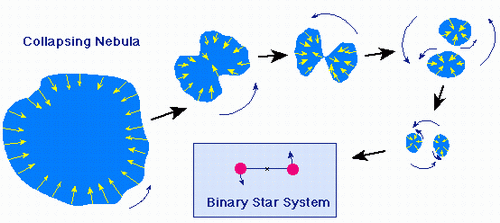 |
|
Alternative to the nebular hypothesis that leads to binary star formation |
Although planets might still form in such binary systems by a similar
mechanism as discussed before, it is an open question whether they would have
stable orbits that would keep them bound in the system without running into the
stars. Another question, assuming such planets were on stable orbits, is whether
they could have temperature ranges favorable for the formation of life.
If Jupiter Had Become a Star . . .
We note in this connection that if
Jupiter had been about 100 times more massive than it is, it would have formed a
star instead of a planet. Thus, maybe the Solar System very nearly became a
binary star system instead of a single star with planets. We may speculate that
in that case the Earth might not even exist, or even if it existed would be in
an orbit giving surface conditions not favorable to the evolution of life.
| 

